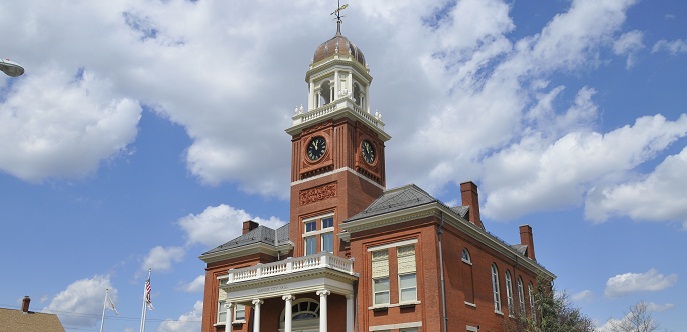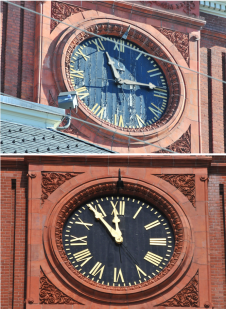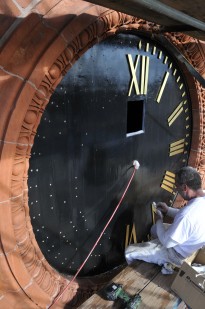Telling the SAT Story: Warwick City Hall Tower and Portico Rehabilitation Project
Warwick City Hall Tower and Portico Rehabilitation Project
Warwick, Rhode Island
Year of Award: 2010
National Park Service SAT Grant: $350,000
Matching Share Leveraged: $434,076
In Warwick, Rhode Island, the recently rehabilitated Warwick City Hall building inspires civic pride in residents and visitors alike, a symbol of rejuvenation in a community emerging from the hard times of economic downturn. The building stands proudly in an area recently rezoned to help stimulate economic redevelopment. The rehabilitated weather vane and dome stand high above other buildings, providing a visual reminder not just of Warwick’s rich history, but also of its bright future. Without a grant from Save America’s Treasures, that future would look a little bleaker.
Founded in 1642, and located just twelve miles from Providence, Warwick is the second largest city in the state, with strong ties to the American Revolution. Warwick City Hall, constructed between 1893 and 1894, has continuously served as the seat of local government since that time. This civic cornerstone is highly visible with approximately 30,000 cars per day passing by on U.S. Route 1. The public visibility of this preservation project sparked interest from a local university in using the building and its restoration as a learning tool. The project also won the 2014 Rhody Project Award, jointly awarded by the Rhode Island Historical Preservation and Heritage Commission and Preserve RI.
Connecting the building to the surrounding community is its massive front portico. Citizens and municipal leaders of Warwick have, for generations, ascended its stairs and passed between its massive Ionic columns to enter this hall of civic pride. Reaching up above the building is its clock tower, topped by a domed, octagonal belfry, with a weather vane at its pinnacle. Each of the four elevations of the tower contains a large clock face, surrounded by decorative terra cotta. These two features—the portico and tower—are the most distinctive and ornate of Warwick City Hall, itself a showpiece of the city.
Unfortunately, after over 100 years of continuous use, Warwick City Hall had extensive deferred maintenance that put the structure at great risk. By the late 1990s, many exterior elements had been removed and stored, and the building was stabilized for two years until funding could be secured to undertake a more complete rehabilitation. However, finding financial support proved difficult, and two years turned into more than ten.
In 2010, the plan became a reality when Warwick secured a $350,000 Save America’s Treasures (SAT) grant to aid in the rehabilitation of the tower and portico, leveraging an additional grant from the Rhode Island Historic Preservation and Heritage Commission. Receiving this grant reinvigorated the Warwick City Council and increased public support for the project, enabling the City Council to finance the remainder of the cost through voter-approved bonds.
Funds in place, work began in the summer of 2013. Project manager Patricia Reynolds prepared plans and specifications for the project and worked with a contractor to complete it, using the Secretary of the Interior’s Standards for Rehabilitation as a guideline for treatments. The scope of work for the project included many specialized skills, and the SAT grant enabled them to find talented craftspeople to assist them.
For example, the rehabilitation of the clock faces required the careful removal of the hands, minute-markers, and roman numerals. While work was done on the surfaces of the clock faces, the removed parts were taken to a shop, where in-kind replacements were precisely fabricated. The octagonal dome of the tower was reclad in lustrous copper. The weather vane, which had been missing its North and South indicators for years, was removed, repaired, refinished, and replaced, with all four directional indicators gleaming in gold. Additionally, the clock-tower bell had, for decades, not rung without the aid of a city employee climbing to the top to strike it with a mallet. The bell wheel—a circular wooden structure that supports the bell and allows it to swing—was removed and a skilled woodworker created an in-kind replacement. In December 2013, the bell tower began ringing again to mark the hour, announcing to the city that after decades, thanks in great part to the SAT grant funding, this long-awaited project was finally complete.
As Ms. Reynolds stated, “without the funding provided by SAT, the building’s future was in jeopardy.” Now that its future is as bright as its gilded weather vane, Warwick City Hall can continue to benefit its community for years to come.
For more information on the City of Warwick, Rhode Island, visit http://www.warwickri.gov/ and the Warwick Rhode Island Digital History Project at http://www.warwickhistory.com/. More background on Warwick City Hall and the Warwick Civic Center National Register Historic District can be found in the National Register Nomination form, at http://www.preservation.ri.gov/pdfs_zips_downloads/national_pdfs/warwick/warw_warwick-civic-center-hd.pdf.
Established in 1999, the Save America’s Treasures program is managed by the National Park Service, with the National Endowment Agencies, to preserve and protect nationally significant properties and collections for future generations of Americans. Stories of saving those treasures will be shared through partnership with the American Architectural Foundation.








